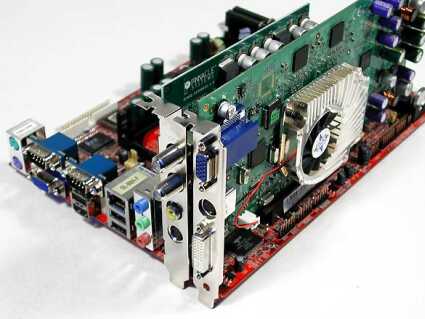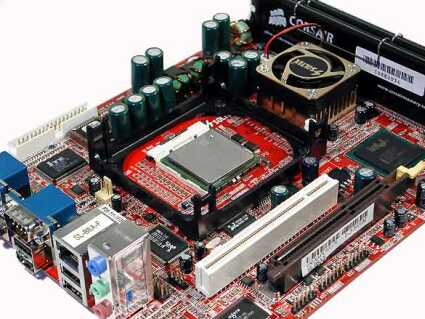Battle of the Minis: Soltek vs. Shuttle
Hardware Check: Similar Features
A direct comparison of the Soltek EQ3000 and the Shuttle SB51G (Intel CPU platform) immediately shows that both systems come with a VGA output and an AGP slot for an optional graphics card - courtesy of the Intel 845E chipset. The simple onboard graphics are certainly good enough for any number of applications, but if you want more, you should consider a high-performance AGP graphics card such as the GeForce 4 Ti 4600 or ATi Radeon 9700 Pro. You won't be able to install the GeForce FX-Monster because the free PCI slot for the cooler is on the wrong side.
All slots filled: the Soltek with GeForce 4 Ti 4600, 512 MB DDR333 (CL2) and a TV card for receiving DVB. Otherwise, everything else is already provided.
Common to both systems is support for fast DDR333 memory (CL2), delivering virtually the same performance if we ignore the marginal differences in the individual benchmark categories. The systems-supported virtual multiprocessing is nothing new, giving P4 CPUs a performance boost under certain conditions by means of Hyper-Threading (as opposed to Pentium processors without HT functionality).
The P4/ 3066 ensures the Soltek's high performance.
Uses For Mini-PCs
Once again, we have listed examples of uses for a Mini-PC to show that a small computer is no different in terms of functionality from conventional, "large" systems. The only thing might be to exercise caution with regard to the Mini-PC's lack of a RAID function.
- All Office and Internet applications;
- Burning CDs and DVDs;
- Video editing (with FireWire and software);
- Working with more than one monitor (Shuttle SN41G2);
- Connecting modern peripheral devices (USB 2.0);
- Optional hard disk RAID setup is not possible due to temperature increases(!);
- TV card and digital video recorder (DVB board);
- Highly complex 3D games (Doom III, Aquanox 2);
- Divx encoding (MPEG 4) of DVD films;
- 3-D rendering (Cinema 4d, 3D Studio Max).
Get Tom's Hardware's best news and in-depth reviews, straight to your inbox.
Current page: Hardware Check: Similar Features
Prev Page Design Comparison: QBic EQ3000 Vs. SB51G/ SN41G2, Continued Next Page Interfaces: From Front USB 2.0 To SP/DIF
